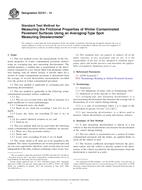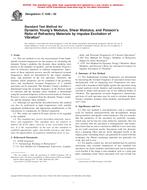1.1 This practice is intended to aid the equipment manufacturer, the installer, the oil supplier and the operator in coordinating their efforts towards obtaining and maintaining clean petroleum fluid hydraulic systems. Of necessity, this practice is generalized due to variations in the type of equipment, builder’s practices, and operating conditions. Constant vigilance is required throughout all phases of design, fabrication, installation, flushing, testing, and operation of hydraulic systems to minimize and reduce the presence of contaminants and to obtain optimum system reliability.
1.2 This practice is presented in the following sequence:
Section Scope 1 Referenced Documents 2 Significance and Use 3 Definitions 4 Types of Contamination 5 General 5.1 Water 5.2 Soluble Contaminants 5.3 Insoluble Contaminants 5.4 Lodged Contamination 5.4.2.1 Suspended Contamination 5.4.2.2 Contamination Control 6 General 6.1 Initial Filling 6.1.1 In-Service Units 6.1.2 Connection of Contamination Control System 6.1.3 Piping to Contamination Control System 6.1.4 Contamination Control Procedures 6.2 Full Flow Contamination Control 6.2.1 Bypass Contamination Control 6.2.2 Batch Contamination Control 6.2.3 Contamination Control Processes 6.3 Gravity 6.3.1 Mechanical 6.3.2 Centrifuge 6.3.2.1 Filters 6.3.2.2 Supplementary Methods 6.3.3 Limitations of Contamination Control Devices 6.3.4 Storage 7 General 7.1 Inspection 8 General 8.1 System Components 8.2 Valves, Strainers and Coolers 8.2.1 Sumps and Tanks 8.2.2 Control Devices 8.2.3 Pumps 8.2.4 Flushing Program 9 General 9.1 Preparation of System for Flushing 9.2 Oil Heating Prior to Flushing 9.3 Selection of Flushing Oil 9.4 System Operation Oil 9.4.1 Special Flushing Oil 9.4.2 Flushing Oil Selection Guide 9.4.3 Flushing Procedure for New Systems 9.5 Flushing Oil Charge 9.5.1 Cleaning of Filtration Devices 9.5.2 Cleaning of System Components 9.5.3 System Flushing 9.5.4 Draining of Flushing Oil 9.5.5 Displacement Oil 9.5.6 Interim Corrosion Protection 9.5.7 New Fluid Charge 9.5.8 Flushing of Used Systems 9.6 General Guidelines 9.6.1 Procedure 9.6.2 System Maintenance 10 Shipping 10.1 Preinstallation 10.2 In-Service Units 10.3 Decision to Flush In-Service Hydraulic Systems 10.4 Fluid Condition Monitoring 11 Fluid Sampling Techniques 11.2 Visual Inspection 11.3 Laboratory Analysis 11.4 Fluid Cleanliness Criteria 11.5 General Information 12 Filter Ratings 12.2 Centrifuge Ratings 12.3 Coalescence 12.4 Vacuum Dehydration 12.5 Adsorption 12.6
1.3 This standard may involve hazardous materials, operations, and equipment. This standard does not purport to address all of the safety problems associated with its use. It is the responsibility of the user of this standard to establish appropriate safety and health practices and determine the applicability of regulatory limitations prior to use.
Product Details
- Published:
- 04/10/1999
- Number of Pages:
- 11
- File Size:
- 1 file , 100 KB


